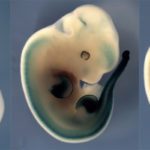Link to Pubmed [PMID] – 23744951
Science 2013 Jun;340(6137):1234167
Hox genes are major determinants of the animal body plan, where they organize structures along both the trunk and appendicular axes. During mouse limb development, Hoxd genes are transcribed in two waves: early on, when the arm and forearm are specified, and later, when digits form. The transition between early and late regulations involves a functional switch between two opposite topological domains. This switch is reflected by a subset of Hoxd genes mapping centrally into the cluster, which initially interact with the telomeric domain and subsequently swing toward the centromeric domain, where they establish new contacts. This transition between independent regulatory landscapes illustrates both the modularity of the limbs and the distinct evolutionary histories of its various pieces. It also allows the formation of an intermediate area of low HOX proteins content, which develops into the wrist, the transition between our arms and our hands. This regulatory strategy accounts for collinear Hox gene regulation in land vertebrate appendages.

